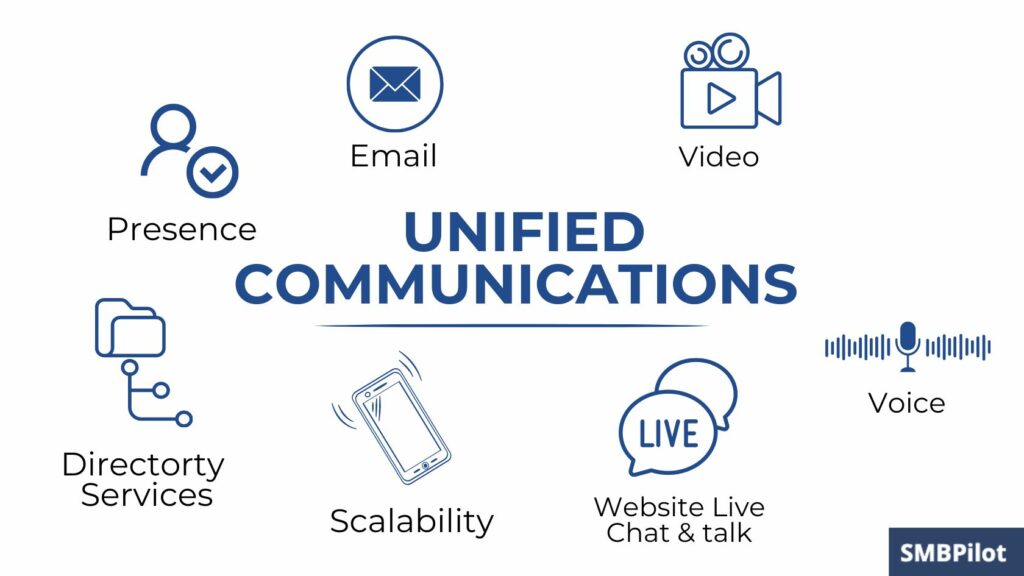Are you struggling to effectively manage multiple communication tools across your business? In today’s fast-paced digital environment, seamless integration of communication technologies isn’t just an advantage; it’s essential for staying ahead. Unified Communications (UC) revolutionizes the way businesses interact internally and with customers by consolidating all communication needs into a single, streamlined platform.
Imagine a workspace where instant messaging, video conferencing, and email converge seamlessly. With UC, this becomes your daily reality. This integration enhances team collaboration and significantly boosts overall productivity and operational efficiency. By simplifying complex communication channels, UC ensures that your team stays connected, no matter where they are.
Now, consider the potential of elevating your business communications to be more agile, integrated, and responsive. Unified Communications is the key to unlocking this potential. UC provides the necessary tools to refine customer interactions, foster a more collaborative team environment, or streamline your business processes.
Take the first step towards transforming your business communications. Read on to discover how Unified Communications can integrate into your operations and help you achieve new heights of success.
What is Unified Communications?
Unified Communications (UC) is a technological framework that integrates various communication channels and collaboration tools on a single platform to enhance business processes. It encompasses real-time communication services such as video conferencing, instant messaging, and IP telephony. Additionally, unified messaging brings together emails, voicemails, and texts for streamlined user experiences.

UC solutions promote team collaboration through advanced features like screen sharing, content sharing, and file sharing, which are accessible across multiple devices, including mobile devices and desktops. This fosters a remote workforce by supporting hybrid work models with tools that ensure business continuity.
Adopting UC also enables seamless integration with existing business applications, which enhances communication and productivity. A UC Communications Platform can operate in a private cloud, ensuring secure and private data handling. A wide range of industries adopts UC to elevate their contact center capabilities and user adoption rates, thereby improving overall business efficiency.
Key Components of Unified Communications:
Real-Time Communication: Video and voice calls, instant messaging
Unified Messaging: Voicemail, email, SMS integration
Collaboration Tools: Screen/desktop sharing, file sharing, video conferencing
Accessibility: Mobile devices, desktops, hybrid workspaces
Integration: Business applications, service providers
UC is essential for maintaining a competitive edge through improved communication channels and collaborative work environments.
Real-time Communication
Real-time communication refers to the instantaneous exchange of information and collaboration between users over the Internet. It is a key component of Unified Communications (UC), allowing for a seamless user experience through various communication channels, such as instant messaging, voice calls, and video conferencing.

Key Features of Real-time Communication:
Instant Messaging: Quick text-based exchanges in real-time
Voice/Video Calls: Face-to-face interaction or voice calls without noticeable delay
Screen Sharing: Sharing of the user’s screen for collaborative work
File Sharing: Transfer of files during live communication sessions
Benefits:
Enhanced Team Collaboration: Teams can work together more efficiently regardless of location.
Improved Business Processes: Real-time decisions and problem-solving speed up business operations.
Flexibility: Supports hybrid work models by connecting remote workforces and in-office staff.
Implementation: To maximise user adoption, real-time communication technologies must be integrated into existing business applications and unified messaging systems, often via a Communications Platform. Support for mobile devices and seamless integration with contact centres and IP telephony ensures business continuity and caters to various communication needs.
Deployment: Service providers typically offer real-time communication solutions through Private cloud or various hybrid models, considering different business sizes and requirements.
Instant Messaging
Instant Messaging (IM) has become an essential component of Unified Communications, facilitating real-time communication between individuals and groups across various business settings. In the context of unified communications, IM offers a rapid, text-based method for employees to exchange information and make prompt decisions, boasting an intuitive and efficient user experience.

Key Aspects of Instant Messaging in Business:
- Real-Time Exchange: Enables instant communication that supports direct and group conversations.
- Integration: Often integrated with other business applications to streamline business processes.
- Mobile Accessibility: Accessible on various mobile devices, ensuring connectivity on-the-go.
- User-Friendly: Offers a straightforward and familiar interface which enhances user adoption.
- Collaboration: Supports tools like screen sharing, file sharing, and content sharing.
Enterprises incorporate IM within their unified communications strategy to ensure that their workforce remains connected—whether in-office, remote, or part of a hybrid work model. Including IM helps maintain business continuity by offering a seamless channel for immediate dialogue and problem-solving.
In summary, IM as part of Unified Communications is not just about quick chats but rather a strategic tool that amplifies team collaboration and contributes to the agility of business operations.
Business Processes
Business processes form the structural foundation of any company, encompassing the sequence of tasks or activities undertaken to deliver a product or service to customers. Efficient processes are central to maximising productivity and staying competitive. Leveraging the right tools, such as Unified Communications (UC), can refine these processes by providing a seamless blend of messaging, voice, and video conferencing solutions.
UC enables real-time communication among teams, facilitating better collaboration and decision-making. With features like instant messaging, screen sharing, and file sharing, team members can work together more effectively, regardless of their physical location. This is particularly beneficial for businesses adopting hybrid work models that cater to both in-office and remote workforces.
Integrating UC within business applications enhances user experience by creating a single platform for various communication channels. This can lead to improved user adoption rates and ensure business continuity, as all vital communications can occur uninterrupted on desktop or mobile devices. Meanwhile, advanced features of UC, such as IP telephony and contact centre integration, support a wide range of business functions, fostering a capable and adaptable business environment.
By enhancing collaboration tools and ensuring seamless integration, UC fortifies business processes, driving them to be more agile and responsive in a swiftly evolving corporate landscape.
Video Conferencing
Video conferencing is a real-time communication tool that allows individuals and businesses to hold face-to-face meetings without needing physical presence. This technology supports unified communications by integrating with various business processes and applications. It offers advanced features, enhancing user experience through high-definition video and audio, screen sharing, and content sharing.

The adoption of video conferencing has grown, particularly with the rise of remote workforces and hybrid work models. It enables teams to maintain business continuity and fosters team collaboration. Users can join meetings from mobile devices or desktops, ensuring flexibility and making it a cornerstone of modern business communication.
A key benefit of video conferencing is its ability to facilitate collaboration tools like file sharing and desktop sharing alongside instant messaging within a single platform. This seamless integration with other communication channels, such as unified messaging and IP telephony, positions video conferencing as a core component of a business’s communications platform, particularly in scenarios like contact centers or private cloud networks.
With a wide range of service providers offering video conferencing solutions, businesses can select platforms that offer the most seamless user adoption, ensuring that their chosen solution aligns well with their communication needs and business applications.
User Experience
Unified Communications (UC) is revolutionising how businesses operate by integrating real-time communication services such as instant messaging, video conferencing, and IP telephony. It enhances user experience by providing a seamless and consistent interface across multiple devices and platforms. The aim is to streamline business processes, making collaboration tools like screen sharing, content sharing, and file sharing easily accessible through a single platform.
User Experience in Unified Communications:
Intuitive Interface: UC platforms prioritise ease of use, ensuring that features like instant messaging and desktop sharing can be used with minimal training, leading to increased user adoption.
Accessibility: Optimised for various devices, UC allows employees to stay connected via mobile devices, facilitating a remote workforce and hybrid work models.
Collaboration Efficiency: Advanced features support team collaboration in real time, enhancing the productivity of business applications.
Integration: Unified messaging and communication channels are integrated into business processes for a coherent workflow.
Reliability: Service providers focus on business continuity, maintaining communication through private cloud and seamless integration technologies.
By converging communication channels into a unified solution, companies create a more connected and efficient environment that empowers both in-office and remote teams to perform at their best.
Unified Messaging
Unified Communications (UC) represents a framework for integrating various asynchronous and real-time communication tools to enhance business communication, collaboration, and productivity. UC merges voice, video conferencing, instant messaging, and email into a single platform, providing a seamless user experience across different devices, including mobile phones, desktops, and tablets.
Key Features of Unified Communications:
Real-Time Communication: Instant messaging and IP telephony for immediate response.
Video Conferencing & Screen Sharing: For interactive face-to-face meetings and presentations regardless of the location.
Unified Messaging: Integration of different messaging systems like email, voicemail, and SMS into a unified user interface.
Collaboration Tools: Platforms facilitate team collaboration with tools for content sharing and project management.
Mobile Devices & Apps: Access to business applications on-the-go, supporting a remote workforce and hybrid work models.
Business Continuity: Ensures communication is maintained without interruption, critical for operational reliability.
Seamless Integration: Brings together multiple business processes and tools for a streamlined workflow.
Adopting UC allows organisations to improve communication efficiency, foster team collaboration, and accommodate evolving business landscapes like the rise of remote work. It enables businesses to provide advanced features under a private cloud or a service provider model which can transform their contact center services and further lead to higher user adoption.
Single Platform
Unified Communications (UC) represents a single platform designed to streamline business processes by integrating various communication channels and collaboration tools. This platform typically combines real-time communication services like instant messaging, video conferencing, and IP telephony with non-real-time communication services such as unified messaging, which includes email, voicemail, and SMS.
The main benefit of a unified communications single platform is the enhancement of user experience by allowing seamless interaction across multiple devices and media types. A single platform simplifies the user interface and provides advanced features like screen sharing, desktop sharing, and file sharing, which are crucial for team collaboration, especially in hybrid work models and among remote workforces.
Major features of a single unified communications platform include:
Real-time communication: video conference, instant messaging
Collaboration enhancement: screen sharing, content sharing
Unified messaging: integrating email, voicemail, SMS, Integration with business applications
Device flexibility: support for mobile devices and desktops
Business continuity: with features like private cloud and seamless integration
Service provider integration: broadening the range of available services
Additionally, managing VoIP bandwidth effectively within a unified communications platform ensures high-quality voice and video calls, crucial for maintaining smooth and uninterrupted communication. Adopting a single unified communications platform can lead to improved user adoption due to its simplicity and ability to integrate with existing contact center operations, all contributing to smarter and more efficient business operations.
Advanced Features
Unified Communications (UC) technology has revolutionised the way businesses communicate and collaborate, bringing with it an array of advanced features that enhance productivity and user experience. One of the standout characteristics of a UC system is its ability to consolidate real-time communication services such as instant messaging, video conferencing, and IP telephony on a single platform.
Key Advanced Features of Unified Communications:
Instant Messaging: Enables real-time text-based communication between individuals or groups.
Video Conferencing: Facilitates virtual meetings with high-definition video feeds, often supported on both desktop and mobile devices.
Screen Sharing: Allows users to share their screens during meetings for collaborative work and presentations.
Unified Messaging: Integrates various messaging and communication channels into a cohesive system.
Contact Center Integration: Empowers contact centers with tools such as customer data access, call routing, and analytics.
Seamless Integration: UC systems integrate seamlessly with existing business applications, ensuring uninterrupted business processes.
Mobile Support: Ensures that team collaboration tools are accessible and fully functional on mobile devices.
Businesses adopting UC platforms can expect improved team collaboration, streamlined business processes, and a robust remote workforce support system, all of which are critical for maintaining business continuity in hybrid work models.
Advanced features in UC platforms are not just about including more functions; they are about creating a more efficient, user-friendly environment that promotes user adoption and accommodates a wide range of communication channels and business needs.
Screen Sharing
Screen Sharing: A Core Feature in Unified Communications
Screen sharing is an essential component of Unified Communications, facilitating real-time communication in various settings. It allows participants to display the content of their computer screen to others, enhancing collaboration and team productivity.
Notable benefits include:
Simplified Explanation of Concepts: Visual aids help clarify complex ideas.
Increased Engagement: Interactive sessions maintain participant interest.
Screen sharing is often integrated within larger platforms offering video conferencing and instant messaging, creating a seamless user experience. It supports business processes by enabling content sharing, such as presentations and documents, without the need for physical presence.
Utilisation Across Devices:
Desktops/Laptops: For comprehensive overview during presentations.
Mobile Devices: For convenience and urgent real-time sharing.
This feature is integral to collaboration tools, being used in various hybrid work models and remote workforce management, thus supporting business continuity. Given its importance, service providers prioritise user adoption through ease of use and provide a wide range of options for desktop sharing, file sharing, and more to meet diverse business needs.
Frequently Asked Questions
What is Unified Communications?
Unified Communications (UC) is a technology framework that integrates various communication channels and collaboration tools onto a single platform, enhancing business processes. It encompasses real-time services like video conferencing and instant messaging alongside unified messaging, which includes emails, voicemails, and texts, all aimed at improving team collaboration and operational efficiency.
How does real-time communication enhance business processes?
Real-time communication allows for instantaneous exchange of information, essential for decision-making and problem-solving in fast-paced environments. It supports features such as instant messaging, voice and video calls, and screen sharing, which are vital for enhancing team collaboration, flexibility, and overall business efficiency.
What are the benefits of integrating instant messaging in business?
Instant Messaging (IM) within Unified Communications facilitates quick, text-based communication that supports both one-on-one and group discussions, crucial for swift decision-making and enhancing operational agility. It is easily accessible on various devices, promoting constant connectivity, especially for remote and hybrid work models.
Why is video conferencing important in today’s business environment?
Video conferencing is a critical component of Unified Communications, allowing face-to-face interactions without physical presence. It integrates seamlessly with other UC features like screen sharing and unified messaging, improving collaboration and maintaining business continuity, which is especially vital in remote and hybrid working setups.
How does Unified Communications improve user experience?
Unified Communications streamline multiple communication tools into a single user interface, making it easier for users to switch between different modes of communication, such as calls, messages, and emails. This integration enhances user experience by providing a consistent and intuitive interface across various devices and platforms.
What should businesses consider when choosing a Unified Communications platform?
When selecting a Unified Communications platform, businesses should evaluate the ease of integration with existing systems, the variety of communication tools offered, the solution’s scalability, and the support for mobile and remote access. Additionally, assessing the provider’s reliability and customer support capabilities is crucial for ensuring a smooth implementation and operation.
These FAQs aim to clarify the key aspects and advantages of Unified Communications, helping businesses make informed decisions about integrating this technology into their operations.
Final Words
Unified Communications (UC) is a transformative force in the modern business, bridging various communication tools into one seamless interface. By converging real-time and non-real-time communication channels, UC enhances the efficiency of business processes and significantly improves team collaboration and flexibility. This integration facilitates a more connected work environment where instant messaging, video conferencing, and unified messaging merge to provide a comprehensive communication experience that is both agile and user-friendly.
The adoption of UC is more than just an upgrade—it is a strategic move towards future-proofing business operations and fostering a robust, adaptable work culture that can thrive in both office-based and remote settings. As businesses continue to navigate the complexities of today’s digital realm, the role of UC becomes increasingly crucial in maintaining competitive edges and enhancing customer interactions. We encourage you to share your experiences or thoughts on how Unified Communications has impacted your business operations or what you consider when choosing a UC platform. Your insights could greatly benefit others who are contemplating this pivotal technology shift. Join the discussion below and let us know your views on the future of business communications with UC.


